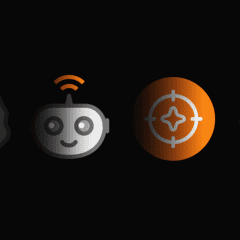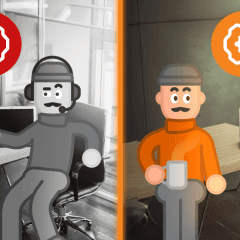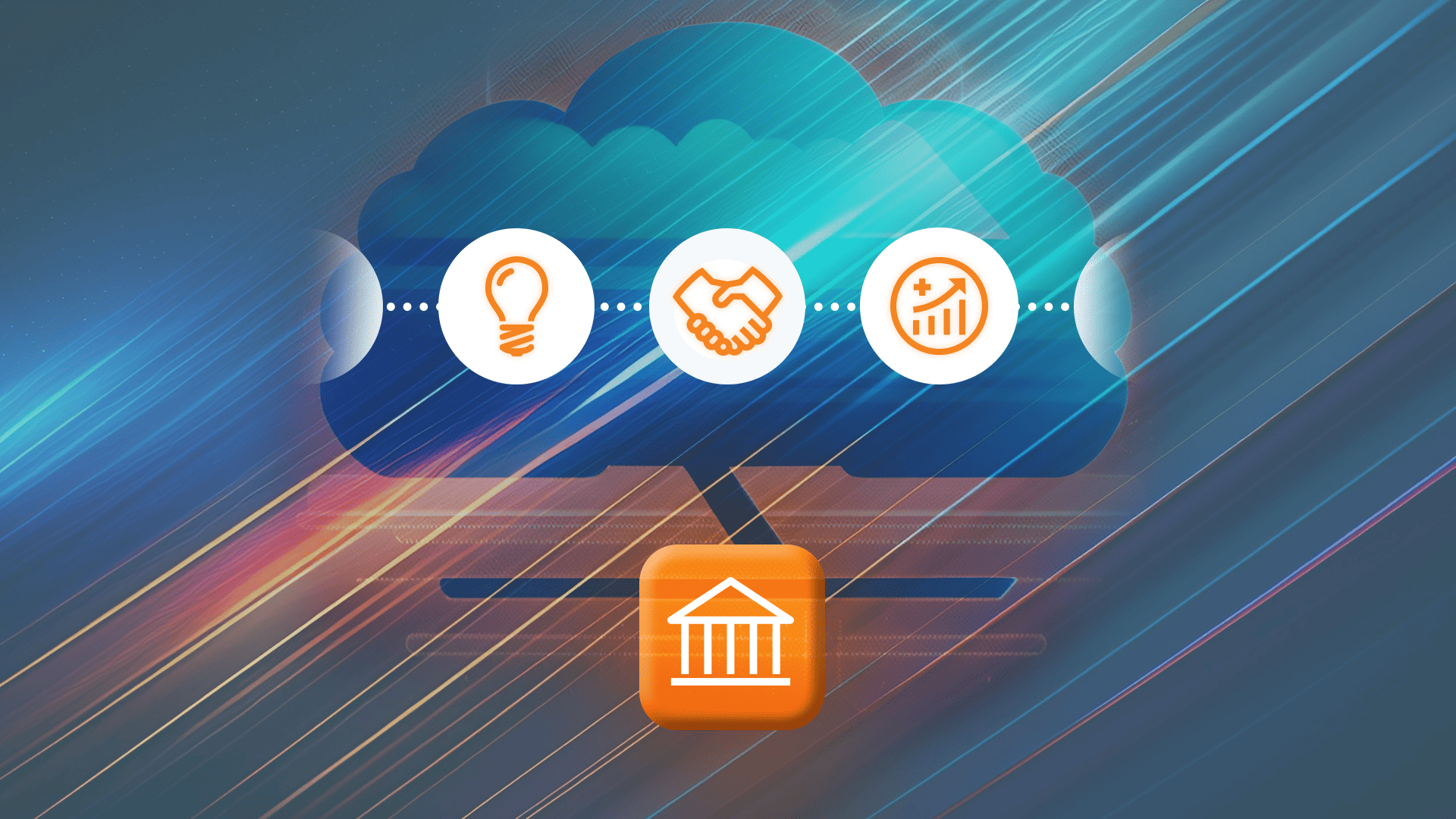Whoosh, so 2021 is over. What a year!😅 We introduced new products (Add-on Mart and PortaPhone by WebTrit), onboarded new customers, performed gradual migrations via DualVersion, launched a new website, built self-care portals for IoT and cloud PBX, and — last but not least — revamped our YouTube channel. It all happened during lockdown and the “new now.” And much of it happened in Ukraine, where we have our technology offices. But despite the tough times, we came together to deliver the next level of customer excellence to you, our dear readers and customers.
Welcome vCC21!
The peak of the year was our virtual Customer Conference 2021 (vCC21). This year’s event took place on December 1st and 2nd, and it was a great boost for customer excellence on all sides. Missed it? Don’t worry. You can still attend async via our conference archive. The event was a new experience for everyone involved – attendees, organizers, speakers, and our valued partners alike. Besides being a good “practice what we preach” milestone, vCC21 also revealed how we should direct our marketing and content efforts in 2022.
As live events are still a no-go in many parts of the world, technology has created new opportunities (and new challenges) for brands and products of all stripes, and particularly so in telecom. On our part, we’re keeping the good old days in mind as we undergo this transformation, and doing everything we can to maintain the same warm and personal relationships we’ve had with our customers since PortaOne first came to be 20 years ago.
To that end, we’ve put together a few vCC21 highlights for you. And while we’re at it, we’d like to present our 2022 “customer excellence resolutions.”
Add-on Mart – Our 2022 “BHAG”
The idea — or, you might say, our “big, hairy, audacious goal” — for the PortaOne iPaaS Marketplace was germinating within the brightest minds on our team throughout the mid-2010s. True, the idea of turning a single product into a product ecosystem has been circulating in the software industry for decades. (And the success of the App Store sped that circulation up quite a bit.) But any participant-driven ecosystem demands that you understand the growth drivers. So our first step was to develop and test a growth hypothesis.
Klaus Haertel, our director for global channel and alliances, was instrumental in figuring that part out out. But then we came up against a new challenge: the name. Our first pick, “iPaaS Marketplace,” was too generic to be noticed by Google. (Not to mention that, for some, it called to mind those “low-level” integrations.)
That’s when Alexandre Starovoitov came up with “Add-on Mart.” Now, we had name that properly reflects what this innovation is: a place for telco executives to shop for new services they can deliver to their subscribers — and where they can access those tools in just a few clicks! (Expect a future story on how Add-on Mart came to be and what it means for our customer excellence.)
Our 2022 Customer Excellence Resolution for Add-on Mart
Right now, less than 10% of our customers are using Add-on Mart or Workflows to expand what their PortaSwitch can do. We want that number to hit 90% — and we want that to happen in just three years. How are we going to drive that kind of change? We’re going to do it just like this:
- Help you expand what you can offer to your end customers. You are not alone! You have the might of the entire PortaOne customer ecosystem standing behind you.
- Reduce your time-to-market even further. Even shorter than our already-speedy 7 weeks? Yes! Add-on Mart uses modern containerization and cloud orchestration technologies, as well as invincible cloud provisioning workflows. That means you can deploy new tools and services in a matter of days, without changing the code on your main PortaSwitch.
- Give you a way to earn back your development costs! As an Add-on Mart partner, you can monetize your own customized PortaSwitch improvements by selling those tools to other telcos in different markets and industry segments. PortaOne partners such as Boom are already doing exactly that.
How the PortaOne Self-care Portal Boosted Customer Excellence
In 2018, we learned that one of our clients in the US had hired a contractor to create their own PBX management portal on top of the standard PortaSwitch UI. This is not unusual — our customers often tweak and personalize our UI to suit their needs. In fact, this kind of flexibility and customer excellence is a key reason why our customers love PortaSwitch.
As it turns out, that contractor was a neighbor of ours based in Poland. So we had a look at the business case, and immediately realized two things. First, this customization was something that multiple PortaOne clients had been trying to resolve on their own. And, second, a “proven to work” development resource now existed to solve that problem for them.
So, we decided to add our own project management to the mix, and turn this idea into a proof-of-concept for developing and publishing portals via Add-on Mart.
Hire the Hackers!
We contacted the Polish developers and invited them to team up with us to create a wider-scale project. We wanted this idea to be something that could benefit our entire customer base.
The first step was to open up our specs and pair the contractor with a dedicated project management team, led by Dmytro Lavraniuk. (Regular readers will remember him as our “customer data migration hero.”) From that point, the project took six months. The outcome? Our new PortaOne Cloud PBX Self-care Portal. Now, our customers’ end users can set up new extensions, use various features such as call forwarding and screening, set up fax mailboxes, provision IP phones automatically via the MAC address, and build auto attendants and complex IVR scenarios. All by themselves!
It’s important to note that this new portal is far more than a beauty facelift. As PortaOne CEO Andriy Zhylenko says: “We invested heavily in the new API behind the scenes. So it’s more than merely ’new dashboard, old machine.’” Also, cloud PBX is not the only industry segment getting a dedicated portal. At vCC21, Oleg Shevtsov (head of the PM Office and Dmytro’s boss, BTW) presented the IoT self-care portal. Expect more portals to come this year, following the road paved by the cloud PBX and IoT segments.
Our 2022 Customer Excellence Resolution for the Self-care Portal
By December 2022, the cloud PBX portal should be deployed for a full three-quarters of our customers who are running a sufficiently modern version of PortaSwitch (MR90+).
PortaPhone: A Remote Office at Your Fingertips
Zoom, Slack, Teams, Skype, Facetime, Meet, Duo, Telegram, and the gang are all great. But what if some or all of your customer’s business relies on the simple phone call? This is a very real situation for many operations — an excellent example is the “call” button you see in Google Maps when you look up a local business. Even today, people often call before they book a stay at a new hotel or even go to eat at a restaurant when they’re abroad. And remember: not every carpenter, dry cleaner, or babysitter has a mobile app. (At least not yet.)
Not convinced? Here’s one more paragraph in defense of the good old landline. The phone call is just the beginning. For instance, before “taking the call,” businesses often have to let the IVR roll, then distribute the workload among their various departments and support teams, then record and integrate the call with their CRM. No doubt, the 🦖OTT tyrannosaurus will be after all of those market segments soon. But for the moment, we are still in 2022. Many “complex voice scenarios” are still in the domain of standard voice calling. (And that’s still done via VoIP behind the scenes.)
What Are the Next Steps?
So how will PortaPhone help you bridge the future with the present? PortaPhone is a product of WebTrit. That company graduated from the PortaOne startup accelerator program (yes, this program exists, despite the lack of a landing page). In addition to the mobile app, PortaPhone also offers the ability to connect to a cloud PBX environment from a Microsoft Teams client without an Office365 subscription. We know that these subscriptions can be far too expensive for most retail and SMB operations… So, we thought, why not give our customers an alternative they can offer?
Expect more features for PortaPhone in 2022.😉 Plus, you can deploy it fast via the cloud with Add-on Mart. Don’t have access to the right kind of cloud data center? No problem: you can still deploy it locally alongside your existing PortaSwitch installation via Docker (beginning with MR75) and bring the rising tide of customer excellence to your business operations.
Our 2022 Customer Excellence Resolution for PortaPhone
By the end of 2022, we plan to have 50,000 active daily users of PortaPhone.
Understanding Wholesale, Wholetail – and Lego Bricks
Every big event needs a keynote star. For vCC21, we brought in Isabelle Paradis. Isabelle is the founder of Hot Telecom, a member of the advisory council at the Pacific Telecommunications Council, and an ambassador for women entrepreneurs at the Young Entrepreneurs Taskforce. At vCC21, she talked about the “perfect technology storm“ that’s underway right now, and what these changes will mean for mid-sized telcos.
Notice that the 2000s get the most prominent gray button from Isabelle. Is that due to coincidence or nostalgia?
Isabelle broke down the four wholesale transformation waves that have swept through the telco industry: deregulation, mobilization, “IPificaiton,“ and verticalization. The most recent one — verticalization — is being driven by Millennials and even Gen Z. Isabelle explained how these generations have radically different expectations for a digital customer experience, and a radically different vision for what customer excellence looks like.
Where Is the Growth?
It’s an important question — watch the presentation for a clear answer from Isabelle.
According to Isabelle, even data is not the lone trending revenue driver in the digital lifestyle era (although it’s still among “the keys”). She reasons: “Players capable of creating viable market offerings in a mix of connectivity, cloud, IoT, content, and security will survive and thrive.”
What Does It All Mean for PortaOne and Our Customers?
Here’s our answer, based on the inspired thinking of Ms. Paradis. Bear with us, because we’re going to frame our answer as an allegory. Think of the Lego brick. These are becoming more and more popular among kids (and business coaches) all over the planet. But to create those bricks, you still need a plastic molding machine. (One that’s ideally located somewhere in China to keep your production costs down.)
To create those bricks, your factory needs a disciplined and capable human operator: someone to launch the machine, procure the materials, and feed them into the system. For telecom companies, our team at PortaOne is precisely that. And now, with the launch of our Add-on Mart, we are also providing a universal interoperability tool. So now that Lego City truck your six-year-old has been playing with can work perfectly with the $699 Imperial Star Destroyer set you got her at Christmas. And then, one day, she might start creating incredible Lego sculptures like the one in the video. In the telco world, that’s where we’re helping you take your end customers.
Surviving with the Help of the Battle-hardened Telco Veterans
Panel discussions are usually the most challenging element to organize when you’re launching an offline conference, never mind a hybrid or virtual one. Remember how we talked about our efforts to map out the right directions for our marketing this year? Holding an online panel was one of those experiments. And it worked! (Though not without a few technical challenges, of course.) To run this experiment, we invited Nick Birtwistle, our long-time partner and the managing director at Boom Communications in the UK, and Aleksandr Dolmatov, product owner at Dzinga and APIFonica in Latvia. The moderator was Enzo Viscito, director of the UCaaS Divison at PortaOne.
Customer Excellence and Profit Drivers
Our panelists laid out a number of different strategies that telcos can use to survive in this era of transition. Here’s what Mr. Birtwistle advised:
- Capitalize on the merger between the telecom and IT sectors. Microsoft Teams has already outcompeted the “large telecom-based” solutions. (Hello, Cisco Webex!)
- Integrate the “telecom domain” (VoIP or PBX) with CRM, automated marketing tools, and business intelligence.
Meanwhile, Mr. Dolmatov put forward these drivers:
- Create related products on top of your existing ones. Think: speech2text and speech analytics or efficiency analysis for ad campaigns.
- “Dig into existing products” by observing how customers use them, and then take what you learn to find new ways of creating value.
Facing Competition from Big Tech? Learn to “Stand on the Giants’ Shoulders”
Yes, there are threats from Google, Microsoft, Apple, and Amazon, said Mr. Birtwistle, but there is also opportunity. As a telco, once you open your APIs (look to WebRTC and PortaPhone for good examples of that), you can create your value proposition on top of what “the giants” are offering. The OTT players are encouraging this. In fact, they aren’t just encouraging it, they’re actually creating new channels for us.
Mr. Dolmatov described a few of those channels being created by the Big 4. Take Microsoft Teams, for example. Sure, the product is excellent. But it needs a solution with local numbering capacity to support storage, convenient time zones, and so on.
No/Low-Code Solutions, APIs, and Other “Lego”
In our panel, Mr. Birtwistle was absolutely shining with optimism. He noted that no-code and low-code tools are essential. He also added that Boom relies on PortaOne for those solutions.😊 Our partners want to keep very limited QA on their side. The big pitfall: you have to know what you’re doing. No-code is for people who understand coding and the technology stack they are dealing with, but who still want to save on development costs. Otherwise, you could be facing huge risks.
Mr. Dolmatov was more reserved. He said that the no-code approach is suitable for prototyping, testing new ideas, or niche markets. But solutions made this way can be challenging to scale and support, and having a failsafe, multi-functional platform still requires professional dev and DevOps teams.
Ok. What’s Next for Customer Excellence?
Judging by the post-conference feedback we’ve received for vCC21, it’s safe to say our customers are happy to see more digital outreach on our side. That’s why we’ll be doing more experimenting with the format and tone of our digital presence in 2022. Weather, COVID, and politics permitting, we plan to organize another digital conference in Summer 2022. We’re calling it hCC22, with the “h” standing for “hybrid mode of participation.”
Customers feeling nostalgia for our cozy conference hall and the murals in Chernihiv will still be able to attend in person. The “let’s do it quick and digital” types can follow via PortaPhone and our virtual conference hall.
PortaOne Customer Excellence Goes Regional
Besides these large-scale community events, we’ll also be continuing to work with our customer communities. That includes our various industry segments (PBX, MVNO, IoT), all the regions we are serving (South Africa, the Balkans, North America, Australia, Latin America, the Baltics), and all the professional roles our operations encompass (techies, support, marketing folk, and so on). The examples set by Slack, Loom, Dropbox, and Atlassian have inspired us. These teams have managed to turn their customer communities into customer ecosystems, where each member of the value chain thrives by helping others.
If you are interested in leading or being a part of one our local customer community groups, please contact us via any convenient means. Because your perspective as a customer is the best tool we have in achieving our 2022 customer excellence resolutions.











